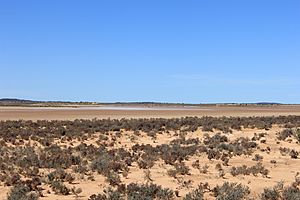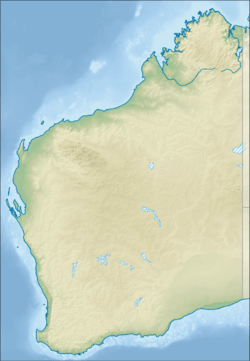Lake Austin (Australia) facts for kids
Quick facts for kids Lake Austin |
|
|---|---|

Lake Austin in autumn 2014
|
|
| Location | Western Australia |
| Coordinates | 27°37′24″S 117°54′48″E / 27.62333°S 117.91333°E |
| Type | Salt lake |
| Catchment area | 13,750 km2 (5,310 sq mi) |
| Basin countries | Australia |
| Max. length | 80 km2 (31 sq mi) |
| Max. width | 40 km2 (15 sq mi) |
| Surface area | 0–980 km2 (0–378 sq mi) |
| Islands | many |
| Settlements | Austin |
Lake Austin is a special kind of salt lake in Western Australia. It's called an ephemeral lake, which means it doesn't always have water. It often dries up and then fills again after heavy rains. You can find it in the Mid West region, about 21 kilometers (13 miles) south of Cue.
The lake was named after Robert Austin, an explorer who explored the area in 1854. There's even an old, abandoned town called Austin located on an island right in the middle of the lake! The Great Northern Highway crosses this island as it goes over the lake. The area around the lake is also known as Lake Austin.
Contents
Discovering Lake Austin
Lake Austin is like a giant natural bowl where water collects and then evaporates. It's part of an "internal drainage system," meaning rivers and streams flow into it, but no water flows out to the ocean. Instead, the water just sits there and evaporates, leaving behind salt.
How Big is Lake Austin?
The lake basin covers a huge area, about 770 square kilometers (297 square miles). If you don't count the many islands within it, the water part is about 440 square kilometers (170 square miles). Lake Austin is very long, stretching about 80 kilometers (50 miles), and it can be anywhere from 10 to 40 kilometers (6 to 25 miles) wide.
Water Levels and Saltiness
This lake usually fills up after big rainstorms, especially during summer and autumn. People say this happens about twice every ten years. When the lake is full, the water is less salty. But as the water evaporates, the salt becomes more concentrated, making the water much saltier.
The bottom of the lake is flat and often covered with a crust of salt. You won't find many plants growing in the lake itself because of the salt. However, around the edges, there's a salt marsh. This marsh is home to special plants called samphire, which can live in very salty soil.
Where Does the Water Come From?
The land around Lake Austin is mostly flat and stony, with many areas that collect water. The lake sits on ancient pathways where water used to flow a long, long time ago. Even deep underground, there are huge supplies of salty water in sandy layers, about 80 to 120 meters (260 to 390 feet) deep.
Every year, the area around Lake Austin gets about 233 millimeters (9 inches) of rain. But the evaporation rate is much higher, around 3,574 millimeters (140 inches) per year. This high evaporation is why the lake often dries up and becomes so salty.
Life Around the Lake
The main activities around Lake Austin are mining and raising animals. There's a large amount of gypsum sand, which is a type of mineral, found on the edge of the lake.
Some years ago, from 1999 to 2002, very salty water from a gold mine nearby was released into Lake Austin. The Austin Downs pastoral station, which is a large farm, also covers part of the lake area. Farmers graze sheep there, and you might also see wild goats and donkeys roaming around.


